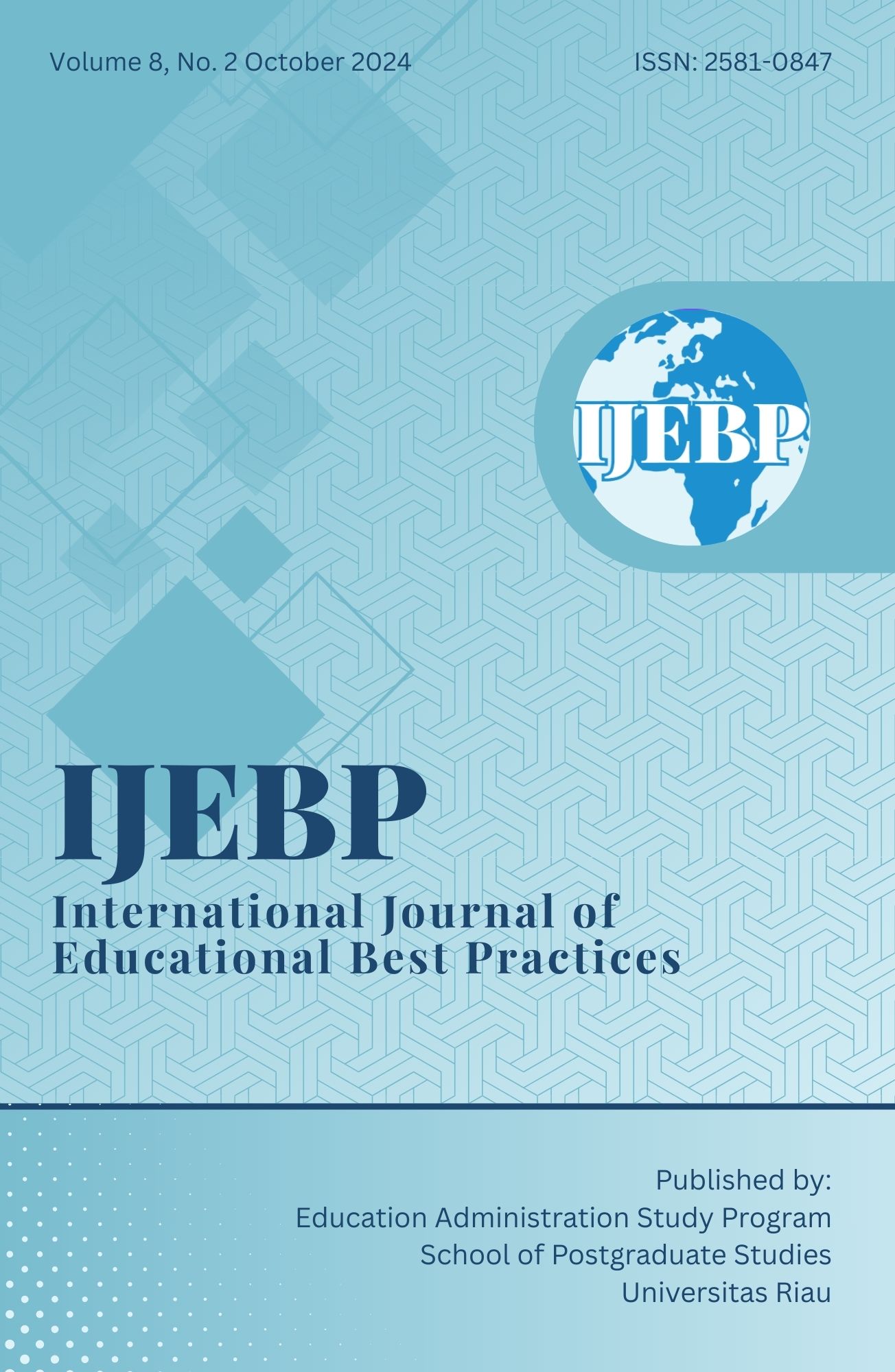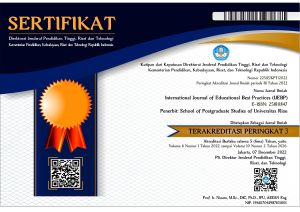STRATEGIES IN DEALING WITH SPEAKING ANXIETY: A MIXED METHOD STUDY ON ENGLISH STUDENTS
DOI:
https://doi.org/10.31258/ijebp.8.2.272-290Keywords:
Anxiety, speaking, strategiesAbstract
This study investigates strategies used by university English department students to overcome their speaking anxiety. It applied an explanatory sequential mixed method. The selected samples of the present study were 71 out of 109 population. Two main instruments used to collect the data were a questionnaire and an interview. The findings indicated that 53 students (3.74) often applied strategies to overcome their speaking anxiety. The result of the quantitative data showed that the overall mean score on the strategy applied by students to overcome speaking anxiety on positive thinking was 3.87, relaxation was 3.98, preparation was 4.05, peer seeking was 3.82, and categorized into high level respectively, while the resignation mean score was 2.99 and categorized into moderate level. Based on the interview results of 10 selected students, they applied five types of strategies above, and some students applied other strategies, such as practicing in front of the mirror and utilizing a learning tool. Since the strategies students apply have overcome their speaking anxiety, students are recommended to implement the above strategies.
References
Abbasi, A. M. (2020). ESL Learners’ Performance Correlates of Social and Academic Anxiety. ELF Annual Research Journal 21, 18(41).
https://www.researchgate.net/publication/338421700
Akfin Rahadian, D., Aminun Omolu, F., & Wulandari, S. (2022). The Techniques of Overcoming Anxiety During Speaking. Journal of Foreign Language and Educational Research, 5(2). https://doi.org/10.31934/jofler.v5i2.2650
Atas, M. (2015). The Reduction of Speaking Anxiety in EFL Learners through Drama Techniques. Procedia - Social and Behavioral Sciences, 176, 961–969. https://doi.org/10.1016/j.sbspro.2015.01.565
Aydin, S. (2008). An Investigation on the Language Anxiety and Fear of Negative Evaluation among Turkish EFL Learners. Asian EFL Journal 30(1): 421–444. https://files.eric.ed.gov/fulltext/ED512266.pdf
Ayres, J. (2009). Coping with speech anxiety: The power of positive thinking. Communication Education, 37(4), 289–296. https://doi.org/10.1080/03634528809378730
Braun, V., & Clarke, V. (2006). Using thematic analysis in psychology. Qualitative Research in Psychology, 3(2), 77–101.
https://doi.org/10.1191/1478088706qp063oa
Chan, C. (2011). Cognitive processes in social anxiety : a study of anticipatory processing, attentional biases and post-event processing. Hong Kong SAR. http://dx.doi.org/10.5353/th_b4765690
Dincer, B., et al. (2022). Breathing therapy and emotional freedom techniques on public speaking anxiety in Turkish nursing students: A randomized controlled study. Explore, 18(2), 226–233. https://doi.org/10.1016/j.explore.2020.11.006
El-Sakka, S. M. F. (2016). Self-Regulated Strategy Instruction for Developing Speaking Proficiency and Reducing Speaking Anxiety of Egyptian University Students. English Language Teaching, 9(12), 22. https://doi.org/10.5539/elt.v9n12p22
Fahmi Irsyad, R., & Narius, D. (2013). Teaching Speaking Through Retelling Stories of Cartoon Movies at Junior High School. Journal of English Language Teaching, 2(1). https://doi.org/10.24036/jelt.v5i1.7277
Fitri, K. (2020). The Correlation Between Anxiety and Students’ Speaking Perfomance in the EFL Classroom [Thesis]. Syarif Hidayatullah Islamic State University Jakarta. https://repository.uinjkt.ac.id/dspace/handle/123456789/51742
Fitriah, & Muna, H. (2019). Foreign Language Speaking Anxiety: A Case Study At English Department of IAIN Lhokseumawe and Al Muslim University. Jurnal Ilmiah DIDAKTIKA, 19(2), 141. http://dx.doi.org/10.22373/jid.v19i2.5030
Flores, A. S. (2024). International Journal of Linguistics, Literature and Translation Coping Mechanisms and Strategies in Overcoming Second Language Speaking Anxiety. International Journal of Linguistics, Literature and Translation. https://doi.org/10.32996/ijllt
Gay, L.R, et al (2011) Educational Research: Competencies for Analysis and Applications. Pearson Education International.
Genç, G., et al (2016). Foreign Language Anxiety and Anxiety Coping Strategies Employed by Turkish EFL Learners. ICERI. https://doi.org/10.21125/iceri.2016.1105
Hadiyanto, H. (2019). The EFL Students’ 21st Century Skill Practices through E-Learning Activitie. Indonesian Research Journal in Education, 3(2). https://doi.org/10.22437/irje.v3i2.8036
Hakim, N. L., & Suniar, Y. (2019). Socio-Affective Strategies In Enhancing Students’ Speaking Motivation. Journal Basis, 6(1). https://doi.org/10.33884/basisupb.v6i1
Hamdani, U. S., et al (2022). Effectiveness of Relaxation Techniques “as an Active Ingredient of Psychological Interventions” to Reduce Distress, Anxiety and Depression in Adolescents: A Systematic Review and Meta-Analysis. International Journal of Health System. https://doi.org/10.21203/rs.3.rs-1346141/v1
He, D. (2017). How to Cope with Foreign Language Speaking Anxiety Effectively? The Case of University Students in China. Electronic Journal of Foreign Language Teaching, 14(2), 159–174. http://e-flt.nus.edu.sg/
Horwitz, E. K., et al (1986). Foreign Language Classroom Anxiety. Source: The Modern Language Journal, 70(2), 125. https://www.jstor.org/stable/327317
Kao, P. C., & Craigie, P. (2013). Coping strategies of Taiwanese university students as predictors of english language learning anxiety. Social Behavior and Personality, 41(3), 411–419. https://doi.org/10.2224/sbp.2013.41.3.411
Khng, K. H. (2017). A better state-of-mind: deep breathing reduces state anxiety and enhances test performance through regulating test cognitions in children. Cognition and Emotion, 31(7), 1502–1510.
https://doi.org/10.1080/02699931.2016.1233095
Kondo, D. S., & Ying-Ling, Y. (2004). Strategies for coping with language anxiety: the case of students of English in Japan. ELT Journal, 58(3). https://doi.org/10.1093/elt/58.3.258
Liu, H. J., & Chen, T. H. (2014). Learner differences among children learning a foreign language: Language anxiety, strategy use, and multiple intelligences. English Language Teaching, 7(6), 1–13. https://doi.org/10.5539/elt.v7n6p1
Marwan, A. (2007). Investigating Students’ Foreign Language Anxiety Ardi, M. Malaysian Journal Of ELT Research, 3. www.melta.org.my
Menzel, K. E., & Carrell, L. J. (1994). The relationship between preparation and performance in public speaking. Communication Education, 43(1), 17–26. https://doi.org/10.1080/03634529409378958
Miles, B. M., & Huberman, M. A. (1994). Qualitative Data Analysis. Sage Publications.
Nath, P. R., Mohamad, M., & Yamat, H. (2017). The Effects of Movies on the Affective Filter and English Acquisition of Low-Achieving English Learners. Creative Education, 08(08), 1357–1378. https://doi.org/10.4236/ce.2017.88096
Paramasivam, S., & Zhiping, D. (2013). Anxiety of Speaking English in Class Among International Students In A Malaysian University. International Journal of Education and Research, 1(11). www.ijern.com
Rahmah, M., & Azhimia, F. (2022). Students’ Speaking Anxiety in Basic Spoken English. Intensive Journal, 05(1). http://ojs.uniska-bjm.ac.id/index.php/EJB
Setiadi, M. A. (2020). An Analysis of The English Students’ Speaking Anxiety in Research Proposal Seminar. https://www.researchgate.net/publication/338571585
Sugiyono, P. (2013). Metodologi Penelitian Kuantitatif, Kualitatif, dan R&D. Alfabeta
Wang, Yu-Chi (2009) Anxiety in English language learning : A case study of Taiwanese university students on a study abroad programme [PhD Thesis]. University of Leeds.
Widhayanti, Z. (2018). English Department Students’ Learning Strategies to Overcome Speaking Anxiety. Retain Journal, 6, 60–67.
https://jurnalmahasiswa.unesa.ac.id
Yang, J., & Yuen, C. K. (2014). College English Teaching Methodology and Language Planning: A Pilot Study in Hefei, China. Procedia - Social and Behavioral Sciences, 118, 495–502. https://doi.org/10.1016/j.sbspro.2014.02.068
Yasuda, T., & Nabei, L. (2018). Effects of Coping Strategies on Language Anxiety of Japanese EFL Learners: Investigating Willingness to Communicate. Journal of Language Teaching and Research, 9 (5), 905-915. https://doi.org/10.17507/jltr.0905.03





